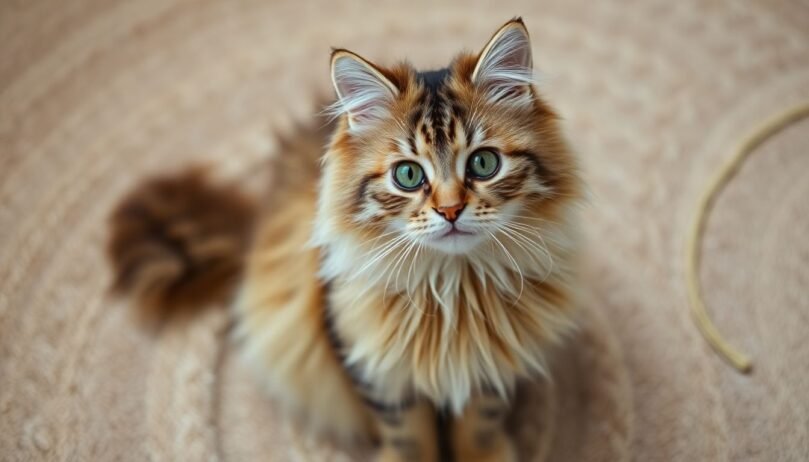Understanding Cat Behavior: What They Trying to Tell You

Understanding Cat Behavior: What Are They Trying to Tell You?
Ever watched your cat suddenly dash across the room for no apparent reason? Or perhaps they’ve sat, staring intently at a wall. Cats, with their mysterious ways, often leave us wondering what they are thinking. Understanding feline communication can be a challenge, but it’s also incredibly rewarding. This article will help you decode common cat behaviors and unlock the secrets of your feline friend.
Decoding Feline Body Language
Body language is essential to how cats communicate. You can learn a lot simply by watching them. Pay attention to their posture and gestures. It really is a window into what they’re feeling.
Tail Talk: Understanding Tail Positions
A cat’s tail is like a flag, signalling their mood. A raised tail usually means happiness or confidence. What does a twitching tail indicate? It could mean playfulness, but also annoyance. A tucked tail shows fear or submission. Watch out if their tail puffs up, as it is a sign of fear or aggression.
The Eyes Have It: Interpreting Eye Signals
Eyes are also crucial for cat communication. Dilated pupils can mean excitement or fear. What about slow blinks? These are a sign of trust and affection. Try slowly blinking at your cat. They might just blink back! A direct stare can be a challenge. Averted gazes are a sign of submission or avoidance.
Ear Positions: What Your Cat is Hearing and Feeling
A cat’s ears are like radar dishes, picking up all sorts of signals. Forward-pointing ears usually mean alertness or interest. Flattened ears show fear, aggression, or irritation. Swivelling ears mean your cat is listening intently to something.
Vocalizations: More Than Just Meows
Cats use a range of sounds to talk. It’s more than just a simple “meow”. They purr, hiss, and growl. Each sound means something different. Understanding these sounds helps to decode their feelings.
The Meaning Behind Meows
Meows have various meanings. Different meows indicate different needs. A short, high-pitched meow is often a greeting. A persistent meow near the food bowl? That probably means your cat is hungry. Some meows seek attention. Others demand it.
Purrs: A Symphony of Contentment… or Not?
Purring usually equals happiness. But it can also indicate self-soothing. Cats may purr when they’re injured or stressed. It may be a form of healing. So, listen to the context.
Hisses, Growls, and Spits: Signs of Aggression or Fear
These sounds indicate that your cat is unhappy. They feel threatened. Hisses, growls, and spits are warning signs. Give your cat space if you hear them. Respect their boundaries.
Common Cat Behaviors Explained
Cats do some strange things, don’t they? Understanding these common behaviours can help strengthen your bond. Let’s explore a few.
Scratching: More Than Just Sharpening Claws
Scratching is normal for cats. It’s not just about sharpening their claws. Cats also scratch to mark their territory. They deposit scent from their paws. This also helps them to stretch. Provide scratching posts to protect your furniture.
Kneading: A Sign of Comfort and Contentment
Does your cat ever knead on you? It’s a sign of comfort. This behaviour links back to kittenhood. They used to knead their mother while nursing.
Head Bunting and Cheek Rubbing: Marking Territory with Affection
Cats have scent glands in their cheeks and head. When they rub against you, they’re marking you. It’s a sign of affection and bonding. They’re claiming you as their own.
Problem Behaviors and Solutions
Sometimes, cats develop problem behaviours. Understanding the causes is key. This helps find the right solution.
Inappropriate Elimination: Litter Box Issues and Stress
If your cat stops using the litter box, there could be a reason. Medical problems or stress could be to blame. Make sure the litter box is clean. Put it in a quiet, accessible spot.
Aggression: Identifying Triggers and Management
Cats can become aggressive for many reasons. Maybe they’re afraid. Or they’re protecting their territory. Introducing a new pet could trigger such aggression. Identify what causes it to find a solution.
Excessive Vocalization: When Meowing Becomes a Problem
Some cats meow a lot. It could be due to medical reasons or behavioral issues. Talk to your vet to rule out any health problems. Provide plenty of stimulation to curb boredom.
Creating a Cat-Friendly Environment
A happy cat is a well-behaved cat. A good environment reduces behavioral problems. Let’s look at what makes a cat happy.
Vertical Space: The Importance of Cat Trees and Shelves
Cats love to climb. They enjoy observing from high places. Cat trees and shelves offer this opportunity. It gives them a sense of security and control.
Interactive Play: Bonding and Exercise
Play keeps cats active and happy. It helps prevent boredom and destructive behaviours. Use interactive toys like wands. This allows them to practice hunting behaviour.
Safe Havens: Providing Quiet Retreats
Every cat needs a safe space. Somewhere they can retreat to when stressed. A quiet room or a covered bed can work.
Conclusion
Understanding cat behaviour isn’t always easy. It requires observation and empathy. By learning to read their body language, vocalizations, and behaviours, you can understand what your cat is trying to tell you. This will allow you to build a stronger bond with your feline friend. Use these tips to better understand your cat today!
For More Advice and Information Contact Your Local Vets !!
Find your loving pet at BuyAPet.co.uk – ENTER HERE
Need Pet Supplies/Accessories BuyAPet Shop is your Number 1 Shop – ENTER HERE
